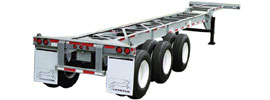“One of the largest driving concerns during times of cold weather is that of following distances. When the roads are slick, your normal following distance needs to double in length for snow and triple in length for icy conditions,” said Don Logan, America’s Road Team Captain (FedEx Freight) from Eskridge, Kan.
Harsh weather is first and foremost a safety concern, not to mention it can cost truckers and transportation companies significant amounts of money and time. The American Trucking Association (ATA) provides winter safety tips which include:
• Map your route: Know where you are going and be prepared, ahead of time, to exit off the highway when needed. Indecisive driving is a major cause of traffic problems.
• Avoid extreme weather conditions.
• Remove ice and snow from your vehicle.
• Slow Down.
• Prepare an emergency kit.
• Watch for black ice.
• Be aware of truck blind spots: If you can’t see the truck driver in his or her mirrors, then the truck driver can’t see you.
• Do not cut in front of large trucks: Remember that trucks are heavier and take longer to make a complete stop.
• Keep your eyes on the road.
• Leave early and avoid risks.
• Buckle up.
For additional information click on winter safety tips.
It is no surprise that the winter of 2013 – 2014, officially the worst winter in 30 years, has disrupted the transportation, logistics and trucking industries. The Northeast and Midwest in particular continue to combat repeated snow and ice storms and severe cold which have resulted in extensive potholes, icy bridges, accidents, lengthy road closures, and numerous other disruptions. These in turn result in greater equipment wear and tear, extended travel times, and difficult economic conditions for truckers and transportation professionals.
The U.S. DOT states that delays due to weather can cost trucking and commercial vehicle companies anywhere from $2.2 to $3.5 billion dollars per year. The U.S. DOT also reports that trucking and commercial vehicle companies spend 32.6 billion vehicle hours in weather-related traffic delays in 281 metropolitan areas in the USA.
In an effort to help state transportation officials manage extreme weather challenges, the American Association of State Highway and Transportation Officials (AASHTO) held a two day symposium in May 2013, covering the impacts and costs of extreme weather on the transportation industry as well as how to effectively manage these events to make important operational decisions.
Allianz Global Corporate & Specialty, a global industrial insurance company, also released The Weather Business, which details how transportation companies can protect themselves against unpredictable weather-related challenges. The 36-page report includes the impact that weather has on businesses, how to protect financial performance, and how to use previous data and forecasts to effectively manage future weather risks.
According to Allianz, about 70% of businesses face weather-related hardships that aren’t necessarily severe every time; in fact, sometimes all it takes is an unexpected or unseasonal weather event to cause serious detriment to a company’s cash flow. Karsten Berlage, Global Head of Weather Risk Management, states that many U.S. companies are still missing the connection between climate and their revenue stream. Identifying this link will become increasingly important in the coming years in order for businesses to manage their profit margins.
Penn Intermodal Leasing can help by offering timely leases on well maintained chassis to help manage cash flow and replace damaged equipment. A well maintained chassis improves safety and minimizes downtime on the road.
offering timely leases on well maintained chassis to help manage cash flow and replace damaged equipment. A well maintained chassis improves safety and minimizes downtime on the road.

